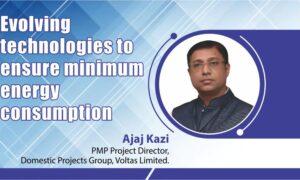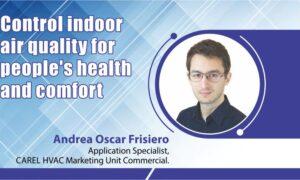Site-personal should be trained well to manage and maintain the proper Indoor Air quality.
What active safety approaches are available to identify risks to protect the building from fire and refrigerant leakages from HVAC systems installed?
“Safety first is Safety always.” Safety should be given the top priority in any of the buildings and especially on the HVAC systems installed in them as safety is everyone’s responsibility.
As the trend is moving towards innovation and improvement on the energy consumption and reducing the carbon footprint by HVAC systems, these units are designed with non-negotiable safety features by the respective OEM’s which address the risk of fire, gas leakages and other elements which can cause risk to the people who are occupying the building. The safety features in HVAC system shall include monitoring the internal as well as external factors for preventative measure’s using advanced Sensors and Controller logic all of which is integrated onto a common controller monitoring common trigger points.
Internal factors
Scope: Risk arising within the HVAC System.
Solution: Sensor monitoring the crucial parameters like refrigerant gas, chilled waters temperature, oil leakage, Voltage, water leakage and other parameters within the HVAC system.
External Factors
- Scope: Risk arising from any external source.
- Solution: Sensor monitoring fire, water hazards arising from external source with the room which the HVAC units detect and triggers an alarm to the user. The HVAC system here refers to Heating, Ventilation, Air conditioning units such as Air handling units, chillers, pumps, cooling tower, ducts and other accessories.
The HVAC Equipment is further bifurcated into-
- Refrigeration / Air conditioning system – Chillers and Pump Rooms
- Air distribution system – Air Handling units, Car Park/ basement ventilation.
The Common hazards, which would arise from HVAC units, would be as below.
Electrical Hazard–
Cause: Continuous operation of any Electro-Mechanical equipment.
Solution:
- Proper ventilation for electrical control panels
- Regular interval inspection of Electrical control panel by competitive authority
- Integrate sensors oxygen/ carbon dioxide/ high temperature/ refrigerant with Building management systems for better monitoring and isolate equipment in case of hazardous situation.
Chemical Hazard-
Cause:
- Refrigerants are non-toxic however in case of refrigerant leakage in large quantity depletes oxygen levels and causes suffocation.
- This may lead to unconsciousness for human being due to low oxygen levels.
- Dry Nitrogen is commonly used in air conditioning / refrigeration systems for pressure testing and flushing of foreign elements in the system,
Solution: Trained and certified man power to be deployed at site.
Connectivity is a critical issue, so alert systems of diagnosing and addressing risk before fault becomes an accident is the key. Do the fire and electrical safety, virus infection safety aspects are important from training point to mitigate the HVAC safety hazard?
As a preventive measure all workmanship at site should be trained and certified while handling sensitive HVAC equipment and critical items like refrigerant gas, oxygen, nitrogen during installation and especially during the current pandemic Covid-19. Site-personal should be trained well to manage and maintain the proper Indoor Air quality by regular check of the Filters, UVG lamps on AHU etc., and must follow all the safety norms as defined. The Facility management team to ensure key Safety training such as the Environment, Health & Safety policy and OHSAS policy and so on to be implemented at site.
Going through current times, what innovations are suggested about the development process of software for HVAC safety? Do we have enough safety guidelines and equipment to meet the needs of present situations like pandemic?
The control system and software logic on the HVAC are completely customisable and are designed to meet the site requirement, while there are certain standard parameters monitoring the critical safety triggers, with the current situation of Covid -19 pandemic Software and controllers could be developed and designed to monitor the Covid -19 virus to keep the virus at bay.
Indoor Air quality and human safety should be given the prime focus while there are norms designed by ISHRAE for Air conditioning and ventilation on how to operate air conditioning and ventilation systems to control spread of corona virus disease (COVID-19) in residences, workspaces and healthcare facilities released on April 13, 2020 which highlights the key safety norms to be followed while operating the HVAC System and selecting the right filters to address the Covid virus and other pathogens by the ASHRAE 52.2 document and Indoor Air Quality standards by the REHVA COVID-19 guidance document and ASHRAE 62 norms. The latest innovation in these systems includes install UVGI Lamps along with the MERV/ HEPA filters to address the Covid -19 virus. The intensity and dosage of UVGCI lamps is selected as per the air velocity from ASHRAE 2012 system and equipment handbook, UVC Germicidal ultraviolet wavelength (254 nm) is effective in penetrating the cell membrane breaking the DNA structure of the microorganism and the recent bipolar ionisation also called needlepoint bipolar ionisation is a technology that can be used in HVAC systems to generate positively and negatively charged particles to help remove viruses including SARS-2-CoV, the virus that causes Covid-19 Also stand-alone air purifier with multi filter installed in a smaller room to address the virus may also be effective, while all these units are designed to address the Covid -19 issue the safety probability still remains at 99.99 percent with all the equipment.
What specific challenges for the HVAC safety have come to the fore as pandemic impact? What sort of systems may be considered vital from a safety point that HVAC technicians must know nowadays?
The challenge at present date is the entry of Covid -19 virus into the building which could cause a serious safety issue to all its occupants.
The covid -19 virus is sized at ≈0.1 μm in diameter and transmits through breathing air that is contaminated by droplets and small airborne particles which are circulated. The key focus should be given on the Indoor Air quality standards and monitor the Supply air which is supplied/ circulated by the Air handling units (AHU). Technicians should have a thorough knowledge on handling the AHU and other high side equipment like chillers as per all the safety standards along with handling of other air distribution unit like ducts and grills to address the current pandemic situation.
Cookie Consent
We use cookies to personalize your experience. By continuing to visit this website you agree to our Terms & Conditions, Privacy Policy and Cookie Policy.














